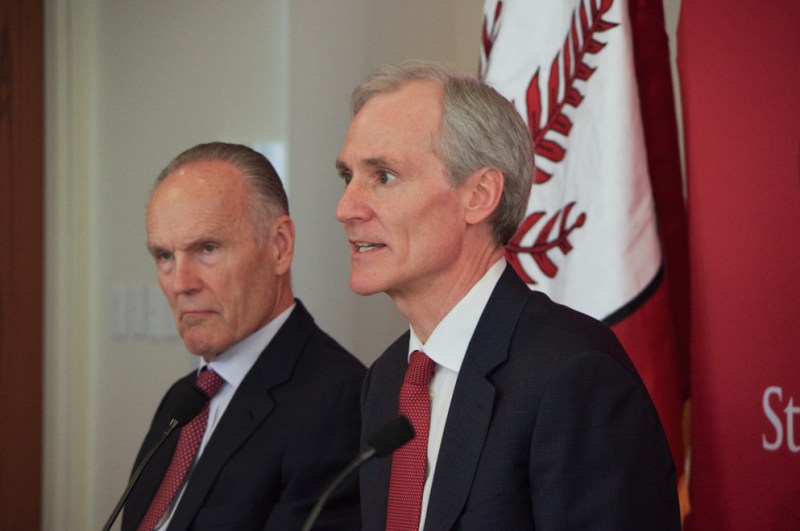The Board of Trustees met this week from April 10 to 12 to hear presentations from a variety of faculty. The Board also had dinners with the Faculty Senate and incoming University President Marc Tessier-Lavigne, who attended Monday’s and Tuesday’s events.
Board Chair Steven Denning MBA ’78 said that he and fellow Board members planned April’s agenda in part to help give “fly-on-the-wall” Tessier-Lavigne a broad sense of Stanford, from science to the arts — particularly because Tessier-Lavigne will not be able to attend the Board’s June meeting due to conflicts with his daughter’s high school graduation and events at The Rockefeller University, where Tessier-Lavigne is still president.
Board members listened to a report from the Presidential Search Committee, which spoke with many higher education leaders across the country before selecting Tessier-Lavigne. The committee discussed what they had learned from this about Stanford’s position in the world of higher education.
While Denning declined to discuss specifics of the report, he called it “a good candid view.”
“There’s often a tendency for the Board to be looking at Stanford from the inside out, so this was a really great opportunity to be looking at Stanford from the outside in.”
After this presentation, Board members bused to the SLAC National Accelerator Laboratory, where they toured the facilities and saw SLAC’s under-construction Linac Coherent Light Source II (LCLS-II) X-ray laser. When it is completed in 2020, the laser — funded with $1 billion from the Department of Energy (DOE) — will be the most powerful instrument of its kind in the world.
According to Denning, Stanford’s current laser is already world-class, but the device will be 10,000 times brighter and 8,000 times faster after the current material upgrade, enhancing its ability to capture motion at the atomic-level.
SLAC is also currently building the world’s largest digital camera, which upon completion will survey the Southern hemisphere from a mountain in Chile.
Denning emphasized the benefit of SLAC’s cutting-edge technology for Stanford community members, noting that 25 joint faculty, 350 Stanford researchers and over 300 graduate students do work at SLAC.
The Board also attended a presentation on Stanford’s arts programming, which Denning said is developing to catch up with Stanford’s growing physical “arts district,” which includes Bing Concert Hall, the Anderson Collection, the art history-oriented McMurtry Building and others.
“We’ve made tremendous progress in expanding the scope and scale of what we offer programmatically to match with the facilities,” Denning said. “Obviously you need the facilities to do the programming, but the programming has been following.”
Richard Saller, dean of the School of Humanities and Sciences and professor of European studies, and Matthew Tiews, associate dean for the advancement of the arts, presented various programs as examples of Stanford’s commitment to growing the arts, from the “creative expression” requirement for undergraduates to the recent stage production of “Rent” and its innovative staging and lighting. They also discussed creative writing as a Stanford program in high demand with great potential to grow further.
However, Denning acknowledged that more can be done to support the arts at Stanford.
“I think we recognize there still is a demand that hasn’t been met with regard to studio space, practice space, what we might need for theater, dance and so forth,” he said.
Four faculty from the economics department presented on their areas of work and spoke about broad changes in the field in the era of “big data.”
Denning said that the presenters — one of whom is a Nobel Prize laureate and three of whom have won the John Bates Clark Medal for economists under 40 — exemplified Stanford’s strength in the field. According to Denning, Stanford’s hiring of top economics professors has helped shift the primary locus of economic scholarship from Harvard and MIT on the East Coast to the Bay Area.
Finally, the Board heard from directors of the Cyber Initiative, founded in 2014 with a $15 million grant from The William and Flora Hewlett Foundation to navigate social, economic and political changes in the digital age. For example, researchers with the initiative are examining how rapid technological advances will change the nature of the workforce.
The Board met with members of Faculty Senate over dinner at Munger. Denning said both trustees and faculty enjoyed getting to know each other casually, outside of the typical faculty presentations.
“Who knows if it’s really the first time it’s ever been done, but there were a lot who claimed that it’s the first time it’s ever been done,” Denning said.
No Board committees met officially.
However, Denning said that the Board did spend both Monday and Tuesday morning discussing a student-led request that the University divest from fossil fuel companies. At the time of the Board’s last meeting in late February, the Board’s Special Committee on Investment Responsibility (SCIR) had just begun to evaluate a recommendation on the issue from the Advisory Panel on Investment Responsibility and Licensing (APIRL).
Denning reaffirmed that he believes the Board will make a decision on fossil fuel divestment by the end of the year.
Contact Hannah Knowles at hknowles ‘at’ stanford.edu.
